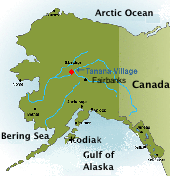Alaska Introduction
One of the cultures that was obvious to visit and document was that of the Native American tribes along the Pacific West Coast. The people in these areas have for generations, long before the arrival of Europeans, lived in a culture that in many ways centered on the large salmon runs that were found in these rivers. The importance that salmon had for the people is expressed in icons, oral history, spirituality, and the faith of tribes from California to Alaska. However, today, a latitudinal gradient of cultural corrosion can be followed as an expression of both the status of salmon runs and the degree of atrocity committed against native peoples by Europeans and the American government.
In the Central Valley, once the largest producer of salmon in California and home to a dense pre-European population, there is little left both of tribal culture and tribal salmon fisheries. This as a consequence of decimation of the salmon runs as well as active persecution of Native Americans during the American western expansion. Farther north, in Seattle, Washington, tribal culture is more noticeable and its connection with the salmon is clear as can be seen in the popular salmon iconic paintings sold in Seattle souvenir shops. Still, tribal salmon fisheries are more of symbolic and ceremonial importance as runs in the Strait of Georgia and Puget Sound have diminished. Today, most of these salmon populations are protected under the Endangered Species Act. Going even farther north in Alaska, salmon runs are still substantial, providing for important commercial fisheries. For the tribes living here, salmon subsistence fisheries are not only of ceremonial importance, but a necessity for survival, a part of the fabric of the society.
In Alaska, I wanted to experience and document true subsistence, where salmon still runs in numbers. What does subsistence mean for the people there? How important is it? What is the social and cultural importance? What species are fished and how? And how are the fish prepared? Thanks to the willingness of the Tanana Tribal Council to support the project and the generous people of Tanana Village, I got some insight into the subsistence salmon fishery along the Yukon River in Alaska.
I also got essential support and the chance to interview staff of the Alaska Department of Fish and Game. Anthropologist Caroline Brown provided both logistical support as well as local and professional information about the people along the Yukon-River and the subsistence fisheries.
